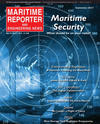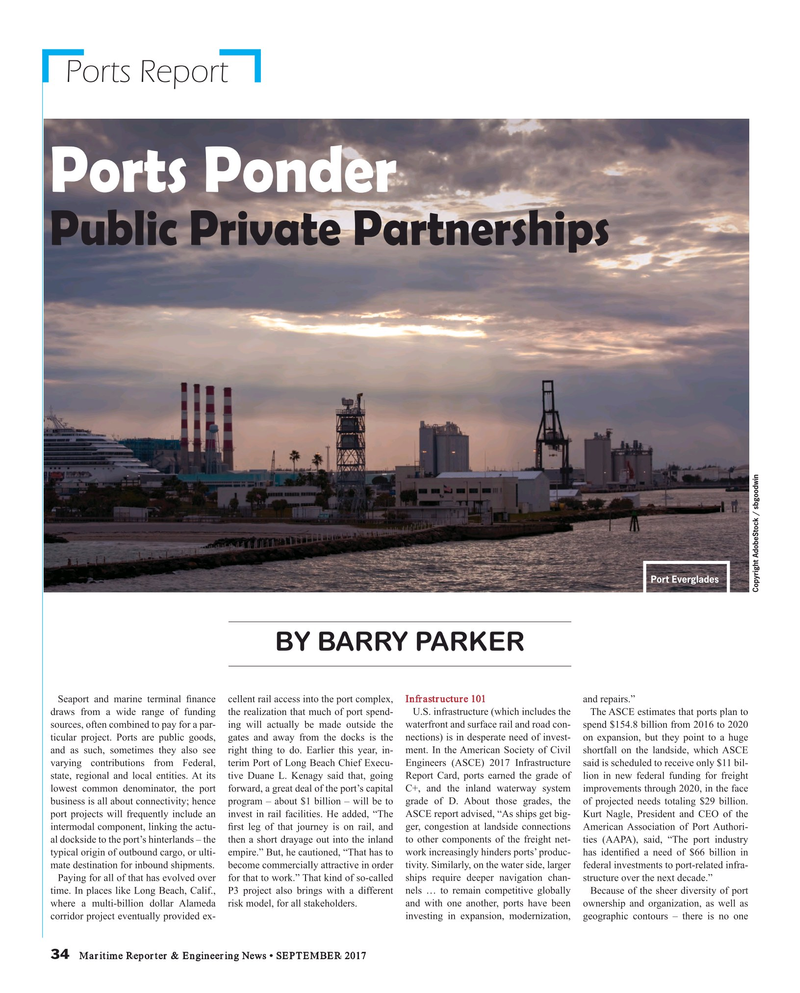
Page 34: of Maritime Reporter Magazine (September 2017)
U.S. Navy Quarterly
Read this page in Pdf, Flash or Html5 edition of September 2017 Maritime Reporter Magazine
Ports Report
Ports Ponder
Public Private Partnerships
Port Everglades
Copyright AdobeStock / sbgoodwin
BY BARRY PARKER
Seaport and marine terminal ? nance cellent rail access into the port complex, Infrastructure 101 and repairs.” draws from a wide range of funding the realization that much of port spend- U.S. infrastructure (which includes the The ASCE estimates that ports plan to sources, often combined to pay for a par- ing will actually be made outside the waterfront and surface rail and road con- spend $154.8 billion from 2016 to 2020 ticular project. Ports are public goods, gates and away from the docks is the nections) is in desperate need of invest- on expansion, but they point to a huge and as such, sometimes they also see right thing to do. Earlier this year, in- ment. In the American Society of Civil shortfall on the landside, which ASCE varying contributions from Federal, terim Port of Long Beach Chief Execu- Engineers (ASCE) 2017 Infrastructure said is scheduled to receive only $11 bil- state, regional and local entities. At its tive Duane L. Kenagy said that, going Report Card, ports earned the grade of lion in new federal funding for freight lowest common denominator, the port forward, a great deal of the port’s capital C+, and the inland waterway system improvements through 2020, in the face business is all about connectivity; hence program – about $1 billion – will be to grade of D. About those grades, the of projected needs totaling $29 billion. port projects will frequently include an invest in rail facilities. He added, “The ASCE report advised, “As ships get big- Kurt Nagle, President and CEO of the intermodal component, linking the actu- ? rst leg of that journey is on rail, and ger, congestion at landside connections American Association of Port Authori- al dockside to the port’s hinterlands – the then a short drayage out into the inland to other components of the freight net- ties (AAPA), said, “The port industry typical origin of outbound cargo, or ulti- empire.” But, he cautioned, “That has to work increasingly hinders ports’ produc- has identi? ed a need of $66 billion in mate destination for inbound shipments. become commercially attractive in order tivity. Similarly, on the water side, larger federal investments to port-related infra-
Paying for all of that has evolved over for that to work.” That kind of so-called ships require deeper navigation chan- structure over the next decade.” time. In places like Long Beach, Calif., P3 project also brings with a different nels … to remain competitive globally Because of the sheer diversity of port where a multi-billion dollar Alameda risk model, for all stakeholders. and with one another, ports have been ownership and organization, as well as corridor project eventually provided ex- investing in expansion, modernization, geographic contours – there is no one 34 Maritime Reporter & Engineering News • SEPTEMBER 2017
MR #9 (34-41).indd 34 MR #9 (34-41).indd 34 9/6/2017 11:03:02 AM9/6/2017 11:03:02 AM

 33
33

 35
35
